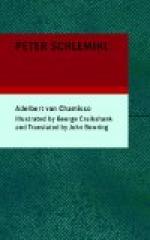|
This section contains 7,056 words (approx. 24 pages at 300 words per page) |

|
SOURCE: "Gold, Guilt and Scholarship: Adelbert von Chamisso's Peter Schlemihl, in The German Quarterly, Vol. LV, No. 1, January, 1982, pp. 49-63.'
In the following essay, Pavlyshyn considers the ending of Peter Schlemihl and the implications of Schlemihl's role as a scientist who refuses to participate in society.
Adelbert von Chamisso's Peter Schlemihls wundersame Geschichte (written in 1813, published 1814) is one of the more frequently interpreted German prose texts of the early nineteenth century. Dörte Brockhagen's Forschungsbericht lists twenty-one studies of the work for the period 1945-76 alone.1 Since then, at least three new titles have appeared, all of considerable importance.2 Yet critical interest has centered upon a limited number of issues—the genre under which the tale is best classified ("Märchen" or "Novelle"?), the applicability to it of the descriptive categories "romantic" and "realistic," and the interpretation of the symbolic significance of the shadow motif—to the...
|
This section contains 7,056 words (approx. 24 pages at 300 words per page) |

|


